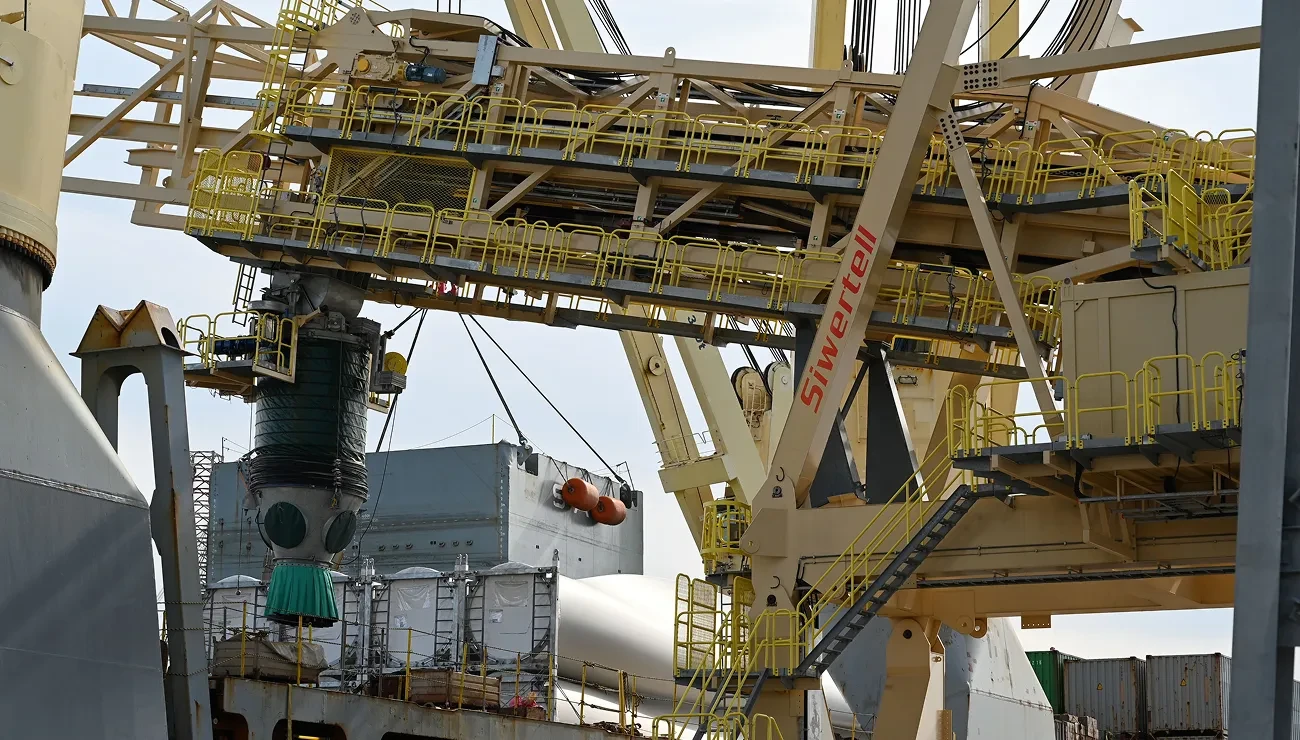
Why should we worry about aging port equipment?
7 May 2025Age is not just a number when it comes to port equipment; with 80 percent of global trade passing through port terminals, they are the gatekeepers of growth, and their equipment must meet rising demands and integrate with modern supply chains
Aging port equipment is probably not at the forefront of most people’s minds; however, it is a global issue. According to the World Bank, more than 80 percent of global trade is transported via sea routes and destined for some of the most complex, multi-stakeholder arenas there are, port terminals.
With increasing trade reliant on older equipment, integrated with modern supply chains, both their structural integrity and productivity are under the spotlight. The age and efficiency of port terminals can have a profound impact on a country’s growth and development, says the World Bank, particularly those driven by exports. Efficient, modern ports instil confidence and attract investment, supporting further growth, global competitiveness and profitability. In contrast, a poorly functioning or inefficient port can hinder trade growth, with a profound impact on the landlocked developing countries (LLDCS) and small island developing states (SIDS).
“Despite 80 percent of the world’s goods, including food and essential construction materials, passing through ports each year, much of the infrastructure supporting this vast global trade network is of considerable age, with much equipment past its expected lifespan and many have reached a tipping point,” explains Daniel Pace Sales Manager, Port Technology.
“Outdated systems not only impact operational efficiency, but can also present safety risks for port workers, and leave port equipment more exposed to the impact of climate change, such as damage from more powerful storm surges and the inability to cope with predicted temperature rises,” continues Daniel Pace.
“The necessity for modernizing port equipment is clearer than ever, especially as the demand for sea-borne cargo and material handling continues to rise, and more advanced technology is already here, available to meet these needs,” stresses Pace.
Bruks Siwertell offers solutions that meet even the most complex dry bulk material handling demands. Large-scale and mobile Siwertell ship unloaders and loaders, Bruks ship loaders, conveying systems and ancillary terminal equipment, such as hoppers and trippers, ensure highly efficient, safe and environment-friendly material flows between ship and shore, and integration within the complex multi-modal landscape environment of today’s major ports.
Keeping pace with demands
“As global trade volumes increase, many ports are struggling to keep pace with demand due to outdated equipment. Aging systems are often undersized, inefficient, and prone to failures, which can lead to significant delays,” notes Daniel Pace.
“When port equipment becomes outdated, it may operate more slowly and require more frequent maintenance, leading to unplanned downtime. This was especially evident during the COVID-19 pandemic when many ports faced backlogs because their older equipment could not keep up with increased demands. This highlights how critical it is for port operators to proactively replace aging equipment before it leads to significant inefficiencies,” Daniel Pace stresses.
Upgrading to modern, high-capacity equipment ensures that cargoes move through ports faster, improving vessel turnarounds on the quayside and boosting jetty utilization rates, with less equipment downtime due to maintenance issues.
Improving safety standards
The safety of port workers should be a top priority for any operator. Old machinery is more likely to fail, potentially leading to accidents and injuries. Furthermore, the structural integrity of older equipment can be compromised due to corrosion, wear, and fatigue. This can make it more dangerous to operate, especially in extreme weathers.
“Cracks and other signs of wear in key components can go unnoticed until a major failure occurs,” says Pace. “Replacing outdated equipment with newer, safer alternatives reduces these risks, with modern equipment not only more reliable but often designed with advanced safety features that help protect workers and reduce the likelihood of accidents. It is also easier to maintain and operate, reducing the risk of human error.”
Upgrading to equipment that meets modern safety standards also allows operators to comply with developing regulations. Ports that invest in timely equipment replacement can avoid the costly fines and reputational damage that result from accidents or non-compliance with safety regulations.
Reducing environmental impact
There is growing pressure for port terminals reduce emissions and waste. Many older pieces of port equipment contribute to excessive dust, noise, and energy consumption, all of which negatively impact the environment.
Bruks Siwertell’s advanced dry bulk handling equipment is designed with environmental sustainability in mind. Ship unloaders, loaders, and conveying systems reduce emissions, prevent material spillage, and use minimal energy.
By investing in environmentally friendly equipment, ports can play a vital role in combating climate change and protecting local ecosystems. Bruks Siwertell technology meets the most stringent environmental regulations while offering outstanding efficiency and operational performance.
Flagship terminals
“Bruks Siwertell is often called in to replace systems that have reached end-of-life expectancy and by these operators choosing Bruks Siwertell, ports can ensure they have equipment that is designed for today's demands, maximizing throughput and environmental protection and minimizing bottlenecks,” Daniel Pace says.
For example, Archer-Daniels-Midland (ADM), the American multinational food processing and commodities corporation, now has a stand-out flagship grain handling terminal in Ama, Louisiana. Since its modernization seven years ago, Ama has repeatedly established new ship loading records, handling a broad range of agribulk materials including wheat, soya beans, milo, corn, meal, and dried distillers’ grains (DDGs).
However, this was not always the case. The terminal had been in operation for decades, but its old equipment had run its course, and had significant dust and spillage issues. For its new set-up, ADM wanted a ship loading system, capable of accommodating post-Panamax sized vessels with enclosed conveyors, enclosed loading spouts and dust collection measures.
ADM approached Bruks Siwertell for a solution. Since 2018, grain exports at the terminal have been underpinned by three Bruks pedestal-mounted, shuttling, slewing ship loaders with completely enclosed loading conveyors, along with six totally enclosed belt conveyors to feed dry bulk material to the ship loaders.
Delivering a rated capacity of around 2,000t/h and loading vessels, up to 115,000 dwt and beam of 43m, the equipment is in near-constant use, offering completely enclosed dry bulk material handling, which not only eliminates waste from spillage, but crucially ensures that grain handling operations are dust free.
Global presence with local support
ADM was a new customer for Bruks Siwertell, and selected Bruks technology not just because of favorable references, but because Bruks Siwertell has the ability to provide turn-key, tailored terminal solutions, and it has a US presence, with local 24/7 support.
As with ADM, Bruks Siwertell works closely with all operators to establish their current needs, but also consider the operational future of the installation, essentially to ensure long-term suitability and the potential for capacity growth as well.
Currently ongoing is a new Bruks ship loader installation at the Port of Long Beach, California, USA. Again, this is for a new customer, and it will replace a system that is approximately 40 years old. “Once ours starts production mid-2026 the old equipment will be decommissioned. This will alleviate capacity challenges and support its continued success,” says Pace.
The new traveling and shuttling Bruks ship loader will handle coal and petcoke at a rated capacity of 5,000t/h, and soda ash, pyrabor and sulphate at 2,000t/h. The ship loader must be totally enclosed and include a full washdown system to allow for cleaning between materials.
“This particular contract was a request for proposal (RFP) issued by the Port of Long Beach to a set of prequalified bidders,” explains Pace. “Bruks Siwertell submitted the best technical and commercial offer by thinking innovatively with a design suggestion alternative to the RFP.”
The time to modernize is now
For port operators, the decision to replace aging equipment is not just about maintaining efficiency, it is about safeguarding the future of their operations. Delaying necessary upgrades risks operational inefficiencies, increased safety hazards, and environmental non-compliance.
“Ports that proactively invest in modern, efficient equipment will be better positioned to meet growing demands, reduce operational costs, and comply with environmental regulations. If I were a port terminal operator today, I would be asking, is my port ready for the future? Do not wait for equipment failures to cause costly delays and safety issues. Partner with Bruks Siwertell today and ensure your port’s equipment is ready to meet tomorrow’s challenges,” Pace concludes.
PLEASE CONTACT US FOR MORE INFORMATION

 Bruks-Siwertell
Bruks-Siwertell